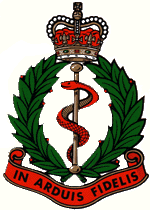195th (Airlanding) Field Ambulance
| 195th (Airlanding) Field Ambualance | |
|---|---|

|
|
| Active | 1943–1948 |
| Country | United Kingdom |
| Branch | British Army |
| Type | Medical |
| Role | Airborne forces |
| Size | Field Ambulance |
| Part of | 6th Airlanding Brigade |
| Engagements |
Normandy landings Rhine crossing |
| Insignia | |
| Emblem of the British Airborne Forces |
 |
The 195th (Airlanding) Field Ambulance was a Royal Army Medical Corps unit of the British airborne forces during the Second World War.
The 195th was the second airlanding Field Ambulance formed by the British Army. Once raised it was assigned to the 6th Airlanding Brigade, which was part of the 6th Airborne Division. It accompanied the brigade on operations, seeing service in the Normandy landings in 1944, and the River Rhine crossing in 1945, after which they remained in Germany following the advance until the end of the war.
At the end of May 1945, the 195th was withdrawn back to England, but by the end of the year had moved with the 6th Airborne Division to the British mandate of Palestine in an internal security role. The 195th served in Palestine until the 6th Airlanding Brigade was disbanded.
Impressed by the success of German airborne operations, during the Battle of France, the British Prime Minister, Winston Churchill, directed the War Office to investigate the possibility of creating a corps of 5,000 parachute troops. In September 1941 the 1st Parachute Brigade began forming, comprising three parachute infantry battalions. In keeping with British Army practice at the same time as the infantry battalions were forming, airborne supporting arms were formed including Royal Army Medical Corps volunteers. Of the seven airborne field ambulances formed during the Second World War, two were glider borne the 181st and the 195th. While the other five were parachute trained the 16th, 127th, 133rd, 224th and the 225th.
...
Wikipedia
